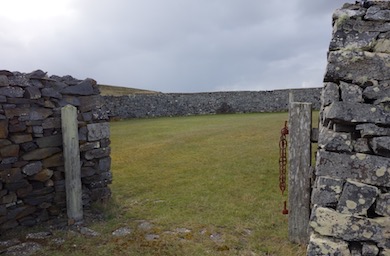Number of results:
Number of results: 29
, currently showing 1 to 20.
HarbourLights Cinema and Event venue
Stanley
The HarbourLights is a multi-purpose cinema and events venue located at the Malvina House Hotel, Stanley.
The 55 seat Cinema, shows the latest Blockbuster and classic films. Enjoy a selection of soft drinks and snacks from the cinema concession’s…
Port Harriet Stone Corral
East Falkland
Corrals were constructed of both stone and turf depending on the site and the availability of materials. They were built by early settlers to the Islands to assist the movement of domesticated animals, originally cattle and later sheep.
Pioneer Cottages
Stanley
Located on Pioneer Row and Drury Street, these cottages were the original colonists' cottages built from 1849 which were brought over in kit form from Britain for the military pensioners who settled on the islands at the time. With the exception of…
Falklands Collectibles
Stanley
Government House
Stanley
Situated towards the western end of Stanley on Ross Road, Government House is both the home and the workplace of the Governor of the Falkland Islands. Work began in 1845 to a design by Governor Moody. The central, stone part of the building was the…
Cartmell Cottage
Stanley
Situated on Pioneer Row in central Stanley, Cartmell Cottage is part of the Falkland Islands Museum and National Trust. Opened in 2003 after donation to the museum, this pioneer cottage belonged to the mother of Nutt Cartmell and is named in his…
Jhelum Shipwreck
Stanley
West of the 1914 Battle Memorial in Stanley Harbour lies the wreck of the Jhelum. Launched in Liverpool in the UK in 1849, the Jhelum suffered damage on its journey from Callao to Dunkirk around Cape Horn, while carrying a caro of guano for use as…
Solar System Sculpture Walk
Stanley
Designed and constructed by local sculptor and artist Rob Yssel, this 1:1 billion scale model is made from recycled local materials and is the only one of its kind. All the planets are in line of sight and the sun sculpture can be seen from every…
Post Office Museum
Fox Bay, West Falkland
A museum that displays the history of the Post Office at Fox Bay. Displays include a counter with postal artefacts, old wooden mail boxes and mail bags, the old Post Office safe, and other historical items dating back to 1899.
Jubilee Villas
Stanley
These villas were built in 1887 to commemorate Queen Victoria's Golden Jubilee. They are typical examples of British terraced town houses of that era, making a curious contrast to the rest of Stanley's architecture.
Port Egmont - First Settlement
Saunders Island
Saunders Island is historically significant as the the location of the first British settlement, established on 23rd January in 1765. Remains of the buildings can be explored along with a plaque marking the spot where the Union Flag was first…
Lady Elizabeth Shipwreck
Stanley
Lying at the east end of Stanley Harbour is Stanley's most imposing and iconic shipwreck. Known as Lady Liz, the ship was launched ain Sunderland in the UK in 1879 and suffered damage whilst rounding Cape Horn in 1913. She limped into Stanley for…
Bodie Creek Bridge
Located a few miles southwest of Goose Green on East Falkland, Bodie Creek Bridge is believed to be the world’s most southerly suspension bridge. Opened in 1925, the bridge was constructed to shorten the journey time moving sheep from Lafonia, an…
North Arm Settlement Museum
North Arm, East Falkland
North Arm Settlement Museum was established in 2005 by a small group of workers from the Falkland Islands Museum and National Trust. The idea for this excellent little museum, which explores the history of the area and of agriculture, came from…
Victory Green
Stanley
Situated in central Stanley, the Islands’ capital on East Falkland, Victory Green is an attractive stretch of land alongside the harbour wall. This is a lovely place to sit on a sunny day, with views to the north side of Stanley Harbour with wooden…
Antarctic Monument (Southern Element)
Stanley
The Antarctic Monument is dedicated to the 28 men and one woman of the British Antarctic Survey who have died in the Antarctic since the first permanent research base was established in 1944. The monument is located in the Historic Dockyard and its…
Ajax Bay
East Falkland
Originally built as a slaughterhouse and refrigeration plant for Falklands’ mutton but then closed when it proved to be economically unviable, the site was used as a field-hospital in the 1982 war between Britain and Argentina. Surgeon Commander…
Historic Dockyard Museum
Stanley
Located on Ross Road, in Stanley, the Historic Dockyard Museum contains many exhibits of social and maritime interest and is a “must-see” for all visitors. Life in the past is exemplified though farming stories, items for entertainment and…
1982 Memorial Wood
Stanley
Memorial Wood is located close to the Stanley Cemetery, an area set aside to commemorate members of the British forces who served and died during the 1982 Falklands War.
Whalebone Arch
Stanley
Adjacent to the cathedral is the Whalebone Arch, constructed in 1933 from the jawbones of two blue whales to commemorate the centenary of continuous British administration in the Falklands.

.png)



 Stone corrals and turf walls were constructed by early settlers in the Islands and splendid examples can still be explored at Darwin and Stanley. Stone buildings survive at a number of locations, though later houses were built from wood due to the ease and cost of importation of light-weight materials.
Stone corrals and turf walls were constructed by early settlers in the Islands and splendid examples can still be explored at Darwin and Stanley. Stone buildings survive at a number of locations, though later houses were built from wood due to the ease and cost of importation of light-weight materials..jpg) Over one hundred ships have been wrecked off Falkland shores, due to gales and hidden rocks. The
Over one hundred ships have been wrecked off Falkland shores, due to gales and hidden rocks. The 





